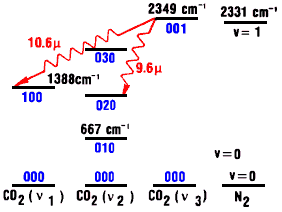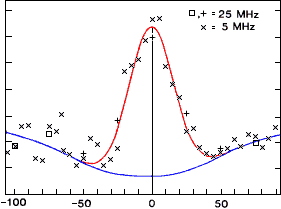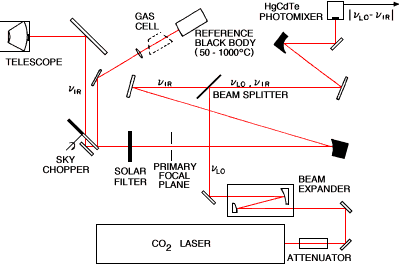Lasers discovered above Mars Pathfinder!
|
|
As Mars Pathfinder
prepared to deploy its rover equipped with laser
navigation, Mother Nature had beaten it to the punch :
Natural lasers have been discovered on mars! |
Discovery of CO2 Laser in Martian Atmosphere
NASA scientists directed a ground based telescope towards Chryse Planitia
the landing site of the
Mars Pathfinder
and discovered naturally occurring laser radiation coming from the upper
martian atmosphere. They used a sophisticated detector called the
'NASA Goddard Space Flight Center InfraRed heterodyne spectrometer'
to scan the emissions. The incredible discovery was confirmed by several
other groups
around the world.
Quantum Description
 The small red circle centered on Chryse Planitia represents the region
over which the laser emissions were detected.
Solar radiation is responsible for pumping a population inversion
in the carbon dioxide of the tenuous upper levels of the atmosphere of Mars
(Mumma et al., 1981)
and Venus
(Deming et al., 1983).
Population inversions have also been found in comets
(Mumma, 1993).
On mars, the solar pump intensity
is strongest near the solar point, and falls off gradually towards the
terminator. There is some locus where the inversion vanishes, but it
is difficult to say exactly where that is.
The R(8) transition at 10.33 microns in the infrared is produced from one
vibrational quanta of asymmetric stretching to one quantum of symmetric
stretching with a change of one quantum of rotational energy from J=8 to
J=7.
(mars image
courtesy : Philip James, University of Toledo; Steven Lee, University of
Colorado; and NASA Hubble Space Telescope)
The small red circle centered on Chryse Planitia represents the region
over which the laser emissions were detected.
Solar radiation is responsible for pumping a population inversion
in the carbon dioxide of the tenuous upper levels of the atmosphere of Mars
(Mumma et al., 1981)
and Venus
(Deming et al., 1983).
Population inversions have also been found in comets
(Mumma, 1993).
On mars, the solar pump intensity
is strongest near the solar point, and falls off gradually towards the
terminator. There is some locus where the inversion vanishes, but it
is difficult to say exactly where that is.
The R(8) transition at 10.33 microns in the infrared is produced from one
vibrational quanta of asymmetric stretching to one quantum of symmetric
stretching with a change of one quantum of rotational energy from J=8 to
J=7.
(mars image
courtesy : Philip James, University of Toledo; Steven Lee, University of
Colorado; and NASA Hubble Space Telescope)
 |
Vibrational energy level diagram depicting the 10.6 micron infrared transition in
the carbon dioxide molecule. (The nitrogen vibrational levels
shown on the right are used to enhance lasing in laboratory lasers) |
Due to the low densities of the lasing species in the
mesosphere and thermosphere of Mars the gain is very low, about 10 percent,
comparable to single-pass gains in some earth based CO2 lasers.
The low gain is partly compensated by the extremely large volumes of active lasing medium.
Over the very long distances scales, the exponential properties of
amplified spontaneous emission
produce a significant spectral signature at the lasing
frequency. The laser amplification has been confirmed by several groups
(Gordiets et al.,
Stepanova et al.
and
Dickinson et al.)

Spectra of martian CO2 emission line as a function of frequency difference from line
center (in MHz). Blue profile is the total emergent intensity in the absence
of laser emission. Red profile is gaussian fit to laser emission line.
Radiation is from a 1.7 arc second beam (half-power width) centered on
Chryse Planitia (long +41 lat +23).
(Mumma et al., 1981)
This unusual infrared emission from CO2 was first observed by students of
Charles Townes
(Johnson et al., 1976),
and later identified as a 'natural laser'. The lines are 100 million times brighter than what
would be expected if thermodynamic equilibrium was established.
The laser emission line can be used as a diagnostic probe of the
temperature and wind patterns on Mars
(Mumma, 1993)
and Venus
(Goldstein, 1991).
Bow and Arrow Analogy |
 |
The emission of a laser photon
by an excited CO2 molecule (below) can be compared
to the release of energy stored in a bow (above) :
When the molecule vibrates or changes its geometry, it snaps back and
emits a photon like a bow launching an arrow.
Image courtesy Dale Gustafson and the National Geographic Society © |
The Goddard infrared heterodyne spectrometer
(Mumma et al., 1978)
used to scan the laser emissions from mars is itself based on
a carbon dioxide laser which produces beats when it is mixed with
the incoming radiation. The process of mixing an external signal with a
precise internal reference oscillator is called heterodyning. The interference
produces two extra signals, one with the sum of both frequencies and another with
their frequency difference.
A filtering system rejects all frequencies except for the difference frequency.
The signal to be measured can be seen as shifted from very high
frequencies (10^14 Hz or terahertz) down to a much lower frequency
(a few hundred MHz) where standard electronics can very easily measure the spectrum
over a narrow wavelength region near the signal's center frequency.
This has been used in radio receivers to downconvert high frequency
signals into intermediate frequency signals that are easier to handle.

Goddard Space Flight Center IR heterodyne spectrometer.
The CO2 laser beam from the bottom (vLO) is mixed with the input signal
(vIR) coming in from the left. The sensitive IR photodetector produces an electronic
signal at the upper right (vLO-vIR) which is further processed by an RF
spectrometer (not shown).
Kostiuk and Mumma (1983).
Practical Use
Thus a terrestrial CO2 laser detects a martian CO2 laser.
Other astrophysical
detectors that use a laser to detect another are
laboratory microwave lasers
attached to radio telescopes which are sometimes used to amplify
natural microwave laser radiation.
There are proposals for realizing a planetary scale laser by placing
mirrors in appropriate orbits
about the planet to enhance the gain and produce oscillation.
(Sherwood, 1988, 1992)
- Mars Global Circulation Model group
- Michael J. Mumma's home page
- Center for Mars Exploration (NASA)
-
Johnson,M., et al. : 1976, Astrophys.J., 208, L145. (online)
-
Mumma,M.J., Buhl,D., Chin,G., Deming,D., Espenak,F., Kostiuk,T.: 1981, Science, 212, 45.
-
Deming,D., Mumma,M.J.: 1983, Icarus, 55, 356. (see also
NASA 83-30342)
-
Gordiets,B.F., Panchenko,V.Ya.: 1983, Cosmic Res. (USA), 21, 725.
(see also NASA 83-30341)
- Kostiuk,T., Mumma,M.J.: 1983, Applied Optics, 22, 2644.
-
Stepanova,G.I., Shved,G.M.: 1985, Sov.Astron.Lett., 11, 390.
-
Dickinson,R.E., Bougher,S.W.: 1986, J.Geophys.Res., 91, 70.
-
Sherwood,B.: 1988, M.Sc. Thesis, NASA CR-180780, (NASA, Washington, DC) see also
Optical SETI and
also here for further references
-
Goldstein,J.J.: 1991, Icarus 94, 45.
- Sherwood,B., et al.: 1992, NASA Conf. Proc. 3166,
(National Aeronautics and Space Administration, Washington, DC), p.637-645.
-
Mumma,M.J.: 1993, in Astrophysical Masers, Clegg,A.W., Nedoluha,G.E. (eds), (Lecture Notes No.412,
Springer Verlag) p.455
-
Espenak,F., Deming,D., Jennings,D., Kostiuk,T., Mumma,M.J., Zipoy,D.: 1983, Icarus, 55, 347.
(see also
NASA 83-29157)
Observations of the 10-micron natural laser emission from the mesospheres of Mars and Venus
-
Loperz-Valverde,M.A., Loperz-Puertas,M.: 1994, J.Geophys.Res., 99, No.E6, 13093.
nLTE radiative transfer model for IR emissions in the atmosphere of Mars.
-
Deming,D., Mumma,M.J., Espenak,F., Kostiuk,T., Zipoy,D.: 1986, Icarus, 66, 366.
Nonthermal emission of 10.33 and 10.72 micron CO2 lines at 23 locations on mars.
-
Mumma,M.J., Deming,D., Espenak,F., Kostiuk,T.: 1986, in NASA
Washington Reports of Planetary Astronomy
Non-thermal emissions from Mars, Jupiter and Comet Halley.

Member of the Internet Link Exchange
Heterodyne Spectroscopy
-
Mumma,M., Kostiuk,T., Cohen,S., Buehl,D., Von Thuna,P.C.:
1975, Space Science Reviews, 17, 661. (see
Workshop on Coherent Detection in Astronomy)
-
Mumma,M.J.: 1978, presented at NATO Advan. Study Inst. on Vibrational Intensities in
Infrared and Raman Spectroscopy.
-
Kaeufl,H.U., Rothermel,H., Drapatz,S.: 1982, ESO Infrared Workshop,
-
Mumma,M.J., Fox,K., Hornstein,J.: 1980, Vibrational-Rotational Spectroscopy For Planetary
Atmospheres
- Mumma,M.J., Kostiuk, Buhl,D.: 1978, Opt.Eng., 17, 50. (see also
1982, Opt.Eng., 21, 313.)
-
Rothermel,H., Kaeufl,H.U., Yu,Y.: 1983, AA, 126, 387.
(see also Kaeufl's
Ph.D. Thesis
and
NASA 85-15538)
-
Schrey,U., Rothermel,H., Kaeufl,H.U., Drapatz,S.: 1985, in
International Symposium on Millimeter and Submillimeter Wave Radio Astronomy, p.213
This page was created by John Talbot and last modified March 1, 1998
The Laser History page outlines a chronology
of other important laser discoveries in space.
For more information on natural lasers
consult the Plasma Laser Astrophysics site:


 The small red circle centered on Chryse Planitia represents the region
over which the laser emissions were detected.
Solar radiation is responsible for pumping a population inversion
in the carbon dioxide of the tenuous upper levels of the atmosphere of Mars
(Mumma et al., 1981)
and Venus
(Deming et al., 1983).
Population inversions have also been found in comets
(Mumma, 1993).
On mars, the solar pump intensity
is strongest near the solar point, and falls off gradually towards the
terminator. There is some locus where the inversion vanishes, but it
is difficult to say exactly where that is.
The R(8) transition at 10.33 microns in the infrared is produced from one
vibrational quanta of asymmetric stretching to one quantum of symmetric
stretching with a change of one quantum of rotational energy from J=8 to
J=7.
(mars image
courtesy : Philip James, University of Toledo; Steven Lee, University of
Colorado; and NASA Hubble Space Telescope)
The small red circle centered on Chryse Planitia represents the region
over which the laser emissions were detected.
Solar radiation is responsible for pumping a population inversion
in the carbon dioxide of the tenuous upper levels of the atmosphere of Mars
(Mumma et al., 1981)
and Venus
(Deming et al., 1983).
Population inversions have also been found in comets
(Mumma, 1993).
On mars, the solar pump intensity
is strongest near the solar point, and falls off gradually towards the
terminator. There is some locus where the inversion vanishes, but it
is difficult to say exactly where that is.
The R(8) transition at 10.33 microns in the infrared is produced from one
vibrational quanta of asymmetric stretching to one quantum of symmetric
stretching with a change of one quantum of rotational energy from J=8 to
J=7.
(mars image
courtesy : Philip James, University of Toledo; Steven Lee, University of
Colorado; and NASA Hubble Space Telescope)



